Globus
The Globus cameras are a range of field and studio cameras made by Ernst Herbst & Firl, in Görlitz and by Ernemann in Dresden. The company merged with Ernemann in about 1899, but the Herbst & Firl identity was retained by the works (as on the maker's plate of the camera shown here), and the Globus range was continued until 1920, when Ernemann sold the Görlitz factory, since the mother company's camera product strategy became focused on hand cameras. A new company, Neue Görlitzer Camera-Werke, took over the factory and production of Globus cameras; this company survived the Second World War, was nationalised as VEB Neue Görlitzer Camera-Werke, and was active until the 1990s.[1]
The name Globus was used for a wide range of different cameras, and is best seen as a trademark rather than a model name, McKeown shows photographs of a tailboard field camera, a conventional folding bed camera, and a studio camera on a large wheeled stand, all named Globus. The example shown here is a Reisekamera, a folding field camera of a pattern characteristic to Germany.
Contents
The Herbst & Firl Globus Reisekamera
The large format camera conception Reisekamera (travel camera) was extremely successful in Germany, but also marketed in UK and France as travel camera or chambre de voyage. Thus this was the mass market for the normal Globus camera models.
- Globus A Mod. I 13x18, swingable back, mahogany wood
- Globus K Series I 9x12, conventional Reisekamera, walnut wood
- Globus K Series II 13x18, conventional Reisekamera with tiltable back
- Globus L 13x18 or 18x24, conventional Reisekamera, tropical wood
- Globus B 13x18 or 18x24, back swingable around vertical and around horizontal axis,
focal plane shutter with speeds 1/50 sec. - 1/2.500 sec. , sunblind holders - Globus G 13x18 or 18x24, mahogani wood, swingable back, tiltable front, perpendicularness check scales, sunblind holders,
ground glass and plate-holding back usable horizontally or vertically, red triple extension square leather bellows,
Of course all these Reisekamera variants had the typical vertically and horizontally shiftable lensboard.
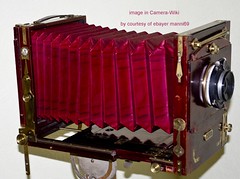
|
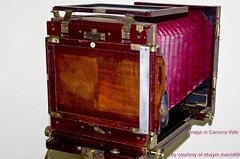 Matte screen swung up, and dark-slide inserted |
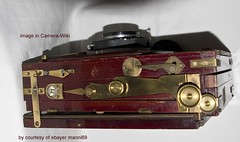 Folded |
| Globus G Reisekamera with triple-extension bellows with rack-and-pinion focusing, and with front rise, shift and tilt, and rear swing. |
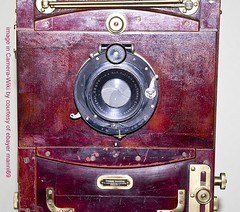
| |
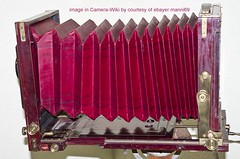
|
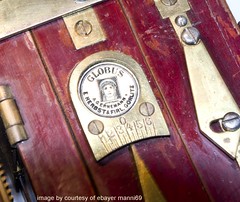
| |
| This example of Herbst & Firl's Ernemann Globus G has an Ernemann Doppelanastigmat Ernon 1:6.8 No.3 f=210mm lens in a Compound leaf-shutter. Note (bottom right) the Ernemann "light goddess"; logo of A.G. Ernemann E.Herbst&Firl Görlitz in the tilt scale of the camera's back. images by eBayer Manni69 (Image rights) | ||
Other original Herbst & Firl models
The Globus M may have been a kind of salon camera, styled like a Reisekamera but mounted on studio tripod. Finest wood finish, swingable back.
The Globus K was a huge studio camera, see Herbst & Firl.
Original Ernemann models
The Globus D was the successor of the versatile field camera Ernemann Windsor, Ernemann's oldest Reisekamera which was still in fixed-rear style, with polished brass instead of original nickel-plated fittings.
The Globus F was a sophisticated folding bed field camera, a bit like Heag IX, with leather-coated outer sides when collapsed, available for formats 9x12, 13x18, 18x24, 24x30.
Notes
- ↑ McKeown, James M. and Joan C. McKeown's Price Guide to Antique and Classic Cameras, 12th Edition, 2005-2006. USA, Centennial Photo Service, 2004. ISBN 0-931838-40-1 (hardcover). ISBN 0-931838-41-X (softcover). p272 (Ernemann) and 716-7 (Neue Görlitzer Camera-Werke).
Links
- Globus A Reisekamera, 13x18 cm, in walnut, about 1905, with 240 mm Goerz Doppel-Anastimat series III, and in mahogany, about 1908, with 265 mm f/6.3 Leitmeyer Sytar, sold at the ninth Westlicht Photographica Auction, in May 2006.
- Globus G in mahogany (the same as the camera shown above), about 1910, with 24 cm f/5.7 Rodenstock Heligonal, sold at the seventh Westlicht auction, in May 2005.
- 18x24 cm Globus 'English pattern' field camera with Star Rapid Rectilinear, sold at Christie's in London in October 1996 (no picture).